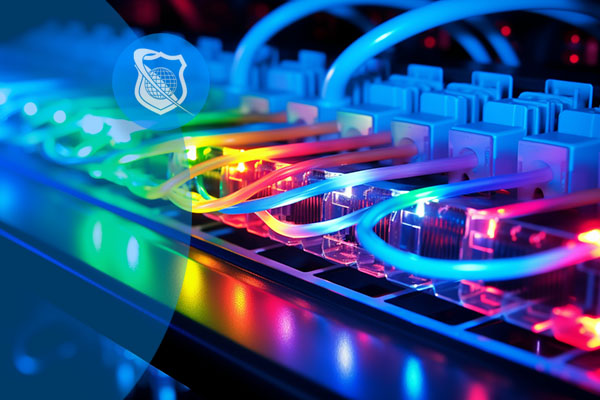Cisco CCNA v1.1 (200-301)
Prepare for the Cisco CCNA 200-301 exam with this comprehensive course covering network fundamentals, IP connectivity, security, and automation. Boost your networking career today!
Included In This Course



Closed Captions



Certificate of Completion
The Cisco Certified Network Associate (CCNA) 200-301 certification is a pivotal credential for IT professionals aiming to excel in networking. Our comprehensive online training course is meticulously designed to prepare you for the 200-301 CCNA v1.1 exam, the essential step toward earning your CCNA certification.
Course Highlights
Our CCNA training program offers an in-depth exploration of key networking concepts, including:
- Routing Protocols: Gain proficiency in OSPFv2 for IPv4, OSPFv3 for IPv6, EIGRP for both IPv4 and IPv6, enabling efficient network routing and management.
- Switching Technologies: Master VLANs, Spanning Tree Protocol (STP), and EtherChannel configurations (static, PAGP, and LACP) to optimize network performance and redundancy.
- WAN Technologies: Understand and implement WAN protocols such as PPP, MLPPP, PPPoE, and GRE to ensure robust and scalable wide-area network connections.
- Quality of Service (QoS): Learn techniques for marking, shaping, and prioritizing voice, video, and data traffic to maintain optimal network service quality.
- Device Monitoring and Management: Utilize SNMPv2 and SNMPv3 for effective device monitoring, and implement AAA protocols with TACACS+ and RADIUS for secure device management.
- Emerging Technologies: Explore the integration of AI and machine learning in network operations to stay ahead in the evolving networking landscape.
Why Choose Our CCNA Training?
- Expert Instruction: Learn from seasoned professionals with extensive experience in Cisco technologies and networking.
- Flexible Learning: Access course materials online at your convenience, allowing you to study at your own pace.
- Comprehensive Coverage: Our curriculum aligns with the latest CCNA exam objectives, ensuring you’re well-prepared for certification.
- Practical Application: Engage in hands-on labs and real-world scenarios to reinforce your understanding and application of networking concepts.
Who Should Enroll?
This course is ideal for:
- Aspiring Network Administrators: Individuals new to networking seeking a structured and thorough introduction to Cisco technologies.
- Current IT Professionals: Experienced network administrators aiming to validate and update their skills in line with current industry standards.
Advance Your Networking Career
Earning your CCNA certification opens doors to various career opportunities, including roles such as network administrator, network engineer, and IT support specialist. Stay competitive in the IT industry by mastering the skills and knowledge that are in high demand.
Enroll Today
Take the next step in your professional journey. Enroll in our Cisco CCNA v1.1 (200-301) online training course and equip yourself with the expertise needed to excel in the networking field.
Frequently Asked Questions Related to Cisco CCNA v1.1 (200-301)
What is the CCNA Certification 200-301?
The CCNA Certification 200-301 is a foundational-level certification offered by Cisco, designed to validate a candidate’s knowledge and skills related to networking fundamentals, IP services, security fundamentals, automation, and programmability. It is one of the most sought-after credentials for networking professionals.
What are the prerequisites for the CCNA 200-301 exam?
There are no formal prerequisites for the CCNA 200-301 exam, but it is recommended that candidates have a basic understanding of networking concepts and some hands-on experience with Cisco devices. Having knowledge of IP addressing and network fundamentals will help in preparing for the exam.
How can I prepare for the CCNA 200-301 certification exam?
To prepare for the CCNA 200-301 exam, you can use Cisco’s official study resources, including the CCNA Study Guide, online courses, lab exercises, and practice tests. It is also beneficial to have practical experience working with Cisco routers and switches to reinforce theoretical knowledge.
What topics are covered in the CCNA 200-301 exam?
The CCNA 200-301 exam covers a broad range of topics, including network fundamentals, network access, IP connectivity, IP services, security fundamentals, automation, and programmability. These topics ensure that candidates have a well-rounded knowledge of networking concepts and Cisco solutions.
How long is the CCNA 200-301 certification valid?
The CCNA 200-301 certification is valid for three years from the date of passing the exam. To maintain the certification, candidates must either pass the recertification exam or earn Continuing Education (CE) credits within the three-year period.
Blogs of Interest Related to This Course
- CompTIA Network+ vs CCNA: A Detailed Guide to Choosing Your Path
- Understanding the Cisco OSPF Network
- Understanding Cisco ACLs: Syntax and Examples
- Dynamic Routing Protocols: Link State vs Distance Vector Explained
- Achieve IT Excellence with Our Comprehensive Team Training Courses
- Unlock Potential: Highly Effective IT Training for Employees Programs
- A Career In Tech Support: Here is Your Typical Day
- IT Classes for Beginners: 5 Essential Courses You Should Take
- CCNA vs Network+ : Which Certification is Right for You?
- The Real Costs : Security Plus Certification Cost vs. Career Benefits
Proudly DisplayYour Achievement
Upon completion of your training, you’ll receive a personalized certificate of completion to help validate to others your new skills.
Cisco 200-301 v1.1 CCNA Course Content
Module 1: CCNA 200-301 v1.1 Network Fundamentals
- 1.1 Intro to Networking
- 1.2 OSI Model
- 1.3 TCP-IP
- 1.4 Network Components
- 1.5 Network Topology
- 1.6 Copper Cable Types
- 1.7 Fiber Optic Cable Types
Module 2: CCNA 200-301 v1.1 Network Device Management
- 2.1 Connecting to a Cisco Device
- 2.1.1 ACTIVITY - Intro to Packet Tracer
- 2.2 Basic Cisco Commands
- 2.2.1 ACTIVITY - Navigating the CLI
- 2.3 Configuring for Connectivity
- 2.3.1 ACTIVITY - Configuring a Router Interface
- 2.3.2 ACTIVITY - Making a Remote Telnet Connection
- 2.3.3 ACT - Making a Remote SSH Connection
- 2.4 Neighbor Discovery
- 2.4.1 ACT - Discovering Neighbors
- 2.5 Basic Troubleshooting
- 2.6 Review
Module 3: CCNA 200-301 v1.1 Switching
- 3.1 Ethernet Basics
- 3.2 Switching Overview
- 3.2.1 ACTIVITY - Setting Up a Simple Switched Network
- 3.3 Spanning-Tree Protocol
- 3.4 Rapid PVST+
- 3.5 VLANs
- 3.6 VLAN Trunking Protocol
- 3.6.1 ACTIVITY - Creating Trunk Links
- 3.7 VLAN Trunking Protocol (VTP)
- 3.8 VLAN Routing
- 3.8.1 ACTIVITY - Configuring the VLAN 1 Interface on a Switch
- 3.8.2 ACTIVITY - Routing Between VLANs
- 3.9 Switchport Configuration
- 3.9.1 ACTIVITY - Configuring Voice and Data VLANs
- 3.10 EtherChannel
- 3.10.1 ACTIVITY - Bundling Links into an EtherChannel
- 3.11 Review
Module 4: CCNA 200-301 v1.1 Internet Protocol (IP)
- 4.1 IPv4 Basics
- 4.2 IP Packet and Interface Types
- 4.3 Binary Numbering System
- 4.4 Classful and Classless Addressing
- 4.5 IPv4 Subnetting
- 4.5.1 ACTIVITY - Moving the Subnet Mask
- 4.6 Subnetting in Other Octets
- 4.6.1 ACTIVITY - Subnetting
- 4.6.2 ACTIVITY - Subnetting by Host Requirements
- 4.6.3 ACTIVITY - Grouping Hosts into Subnets
- 4.7 Supernetting
- 4.7.1 ACTIVITY - Supernetting
- 4.8 IPv6
- 4.9 Review
Module 5: CCNA 200-301 v1.1 Routing
- 5.1 Introducing the Route
- 5.2 Routing Basics
- 5.3 Packet Delivery on the Same Network
- 5.4 IP Routing Across a Single Router
- 5.4.1 ACTIVITY - Configuring Basic Routing
- 5.5 IP Routing Across Multiple Routers
- 5.5.1 ACTIVITY - Configuring IPv4 Static Routes
- 5.5.2 ACTIVITY - Adding Special Static Routes
- 5.6 Routing Protocols Overview
- 5.7 Route Selection
- 5.8 Open Shortest Path First (OSPF)
- 5.8.1 ACTIVITY - Deploying Single Area OSPF
- 5.9 First Hop Redundancy Protocol (FHRP)
- 5.10 Network Address Translation (NAT)
- 5.10.1 ACTIVITY - Implementing Static NAT
- 5.10.2 ACTIVITY - Using a NAT Pool
- 5.10.3 ACTIVITY - Configuring PAT
- 5.11 Review
Module 6: CCNA 200-301 v1.1 IP Services
- 6.1 Remote Control
- 6.2 File Transfer
- 6.3 Monitoring
- 6.4 Infrastructure
- 6.4.1 ACTIVITY - Implementing a DHCP Relay
- 6.5 Quality of Service
- 6.6 Review
Module 7: CCNA 200-301 v1.1 Wireless
- 7.1 Wi-Fi Principles
- 7.2 Cisco Wireless Architectures
- 7.3 WLC Configuration
- 7.3.1 ACT - Configuring a WLAN
- 7.4 Review
Module 8: CCNA 200-301 v1.1 Security Fundamentals
- 8.1 Intro to Security
- 8.2 Local Device Access Control
- 8.3 Protecting Privileged EXEC Mode
- 8.4 Password Management
- 8.5 Local User
- 8.6 Password Recovery
- 8.6.1 ACTIVITY - Password Recovery
- 8.7 Remote Access
- 8.8 Access Control List (ACL)
- 8.8.1 ACTIVITY - Deploying a Standard ACL
- 8.8.2 ACTIVITY - Deploying an Extended ACL
- 8.9 DHCP Snooping
- 8.10 Dynamic ARP Inspection (DAI)
- 8.11 Layer 2 Port Security
- 8.11.1 ACTIVITY - Securing Layer 2 Ports
- 8.12 Authentication, Authorization and Accounting (AAA)
- 8.13 Wireless Security
- 8.14 Review
Module 9: CCNA 200-301 v1.1 Automation and Programmability
- 9.1 Network Automation Overview
- 9.2 Software Defined Networks
- 9.3 JSON
- 9.4 REST APIs
- 9.5 Management Mechanisms
- 9.6 AI in Network Operations
- 9.7 Review
| 5 star | 82 | 82% |
| 4 star | 17 | 17% |
| 3 star | 1 | 1% |
| 2 star | 0% | |
| 1 star | 0% |
Sorry, no reviews match your current selections
Your Training Instructor
Chrys Thorsen is an education and technology expert who specializes in enterprise-level IT infrastructure consulting and certified training-of-trainers. In her career, she has garnered over 50 IT Certifications including CISSP, CISA, CEHv12, PenTest+, CompTIA CNVP, Cisco CCSI/CCNP, Microsoft Cloud and on-premises technologies, VMware vSphere, and many more. She has also authored 40 published certification textbooks, and over 35 full-length IT certification video courses.
When not working in the United States, Chrys spends her time abroad capacity-building IT literacy in developing nations in Sub-Saharan Africa. Her client list has included: the US Federal Government, the Republic of Zambia Ministry of Health, Cavendish University Zambia, Accenture, JP Morgan Chase, the US Centers for Disease Control and Prevention, the Elizabeth Glaser Pediatric AIDS Foundation (EGPAF), Hughes Aircraft, Microsoft, and many more.
Chrys lives by, and is fond of repeating, her professional creed:
“The only true measure of success for any project or training is results on the ground. Everything else is just noise.” “I teach what I deploy; I deploy what I teach.”

Subscribe To All-Access
Lock In $16.99 / Month Forever
Access this course and over 2,700 hours of focused IT training. Start your first month for only $1.00. Then lock in only $16.99 / month for life.
- Get Every Course
- Free Updates / New Content Added
- 2,700+ Hours of Training
- Price Lock Guarantee
- Games / Flashcards
- 21,000+ Practice Questions
$49.99 $16.99 Monthly
$49.00





good
Smooth delivery and easy access to LMS. Good to see that the LMS offers progress tracking. Would be great if badges were offered on completion of courses to share via Credly to future employers.